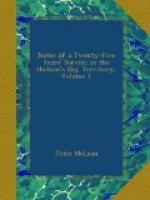During winter the sky is frequently illuminated by the Aurora Borealis even in the day-time; and I have observed that when the south wind, the coldest in this quarter, (traversing, as it does, the frost-bound regions of Canada and Labrador,) blows for any length of time, the sky becomes clear, and the aurora disappears. No sooner, however, does the east wind blow, which, being charged with the vapours of the Atlantic, induces mild weather even in midwinter, than they again dart forth their coruscations—more brightly at first, afterwards more faintly, till, if the wind continue, they again disappear.
These phenomena seem to warrant the conclusion that the aurora is produced by the evolving of the electric fluid, through the collision of bodies of cold and warm air. The same phenomena are observable in New Caledonia; the east wind, passing over the glaciers of the Rocky Mountains, cools the atmosphere to such a degree as to cause frost every month in summer; the west wind, on the contrary, causes heat; and there, as in Ungava, the change of winds is followed by what may be termed the Mountain Aurora (Aurora Montium?)
During my residence of five years at Ungava, the thermometer fell twice to 53 deg. below zero; and frequently ranged from 38 deg. to 48 deg. for several days together; the extreme heat rose to 100 deg. at noon in the shade.
The soil of Ungava consists principally of decayed lichens, which form a substance resembling the peat moss of the Scottish moors. In this soil the lily-white “Cana” grows, a plant which I have not seen in any other part of the continent, although it may elsewhere be found in similar situations. In the low grounds along the banks of rivers, the soil is generally deep and fertile enough to produce timber of a large size; in the valleys are found clumps of wood, which become more and more stunted as they creep up the sides of the sterile hills, till at length they degenerate into lowly shrubs. The woods bordering on the sea-coast consist entirely of larch; which also predominates in the interior, intermixed with white pine, and a few poplars and birches. The hardy willow vegetates wherever it can find a particle of soil to take root in; and the plant denominated Labrador tea, flourishes luxuriantly in its native soil. In favourable seasons the country is covered with every variety of berries—blueberry, cranberry, gooseberry, red currant, strawberry, raspberry, ground raspberry (rubus arcticus), and the billberry (rubus chamaemorus), a delicious fruit produced in the swamps, and bearing some resemblance to the strawberry in shape, but different in flavour and colour, being yellow when ripe. Liquorice root is found on the banks of South River.




